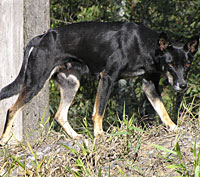
Wild dogs and dingoes

A wild dog is any free-ranging dog without an owner and includes domestic dogs living in the wild.
Dingoes are identified as 'native wildlife' under the Nature Conservation Act 1992, and are protected in national parks. Under the Biosecurity Act 2014 , dingoes are a 'restricted invasive animal' outside of national parks and must not be moved, fed, given away, sold, or released into the environment without a permit.
Where they occur outside of protected areas, wild dogs pose a serious threat to native wildlife and domestic animals and are managed as described in the Brisbane Invasive Species Management Plan 2013-2017.
Wild dog general facts
Wild dogs:
- can potentially produce two litters of four to six pups per year
- red, ginger and sandy-yellow are the dominant coat colours, though dingoes can also be pure white, black and tan or solid black
- vary in colour from black to a reddish brown
- are often seen during the day in urban areas
- howl to attract pack members and repel intruders from their territory
- are territorial and may be aggressive if threatened, especially in situations where packs of dogs are encountered
- can travel considerable distances in search of food
- weigh from 12-15kg (dingo) but can vary in weight from 8kg to 38kg depending on ancestry
- usually breed between April and June.
Problems with wild dogs
Wild dogs pose a serious threat to native wildlife and may prey on a variety of species from small frogs and reptiles to adult kangaroos and wallabies. In isolated remnant pockets of forest, wild dogs can have devastating impacts on local wildlife species. They can also injure or kill domestic pets, livestock or poultry.
Wild dog management
Land owners can remedy a wild dog problem on their property by using exclusion fencing. If you enclose your property with pest animal exclusion fencing will make it less attractive to wild dogs.
Fencing should be about 1.8 metres high and should be buried under the ground at least 150mm to prevent wild dogs from digging under. The most commonly used mesh size is 75mm square.
Due to the cost, you may want to use pest animal exclusion fencing only around specific areas like poultry pens and small livestock. This is also effective.
Other wild dog management measures
- You should never feed or attempt to befriend wild dogs - wild dogs that lose their fear of humans are a hazard.
- Keep your pets inside at night - a wild dog will attack domestic dogs and any other pet or native animal if the opportunity arises.
- Stay away from wild dogs, but if one approaches you, do not run as this can stimulate their instinct to chase.
- If a wild dog approaches a horse with rider, the rider should calmly walk the horse away from the dog.
More information
Find out more information about wild dogs or their management, phone Council on 07 3403 8888. You can also find information about keeping a dog.